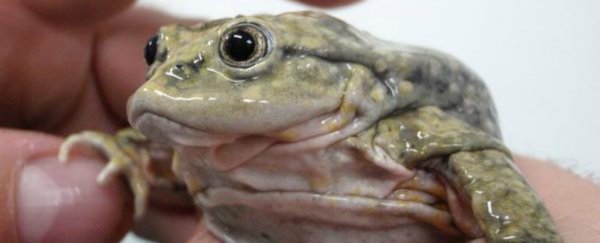Authorities in Peru are trying to figure out how more than 10,000 critically endangered Titicaca water frogs (Telmatobius culeus) – also known as scrotum frogs – have suddenly dropped dead around Lake Titicaca.
So far, conservationists are claiming that pollution in the Coata River, a site that they have tried and failed to get the government to clean up, is likely to blame, though no official verdict has been released.
"Based on local residents' statements and samples taken in the days after the incident, it is believed that more than 10,000 frogs were affected over about 50 kilometres [30 miles]," said Peru's National Forestry and Wildlife Service (SEFOR).
First off, what exactly is a scrotum frog? For starters, they're nicknamed Titicaca scrotum frogs because of their wrinkly excess skin that actually increases their surface area, helping them absorb more oxygen.
Besides the not-so-glamourous name, the frogs are gigantic, weighing in at about 1 kilogram (2.2 pounds) a pop, and are only found in and around Lake Titicaca, which lies on the border of Peru and Bolivia.
Scrotum frogs have become rarer and rarer over the last two decades because of over-harvesting, habitat loss, and the abundance of an invasive species of trout that continue to eat their tadpoles, leaving them on the brink of extinction.
Now, activists say a whole new problem has sprung up at Lake Titicaca: rampant pollution, which they brought to the SEFOR's attention by taking about 100 of the dead frogs to their central office.
"I've had to bring them the dead frogs. The authorities don't realise how we're living," activist leader and local resident Maruja Inquilla, from the Committee to Combat Pollution of the Coata River, told the AFP.
"They have no idea how major the pollution is. The situation is maddening."
To be clear, authorities haven't officially identified that the thousands of dead frogs are a result of pollution in the river. But they did say that they found sludge and solid waste during another investigation at the site.
Activists and residents living nearby suggest that the problem stems from sewage runoff from Juliaca – an urbanised city not far from the site – and say the government has been ignoring repeated demands to build a sewage treatment plant along the Coata River to curb the issue.
Peruvian authorities have remained tight-lipped on the matter. So far, they have sent samples of the frogs off to specialists at the Denver Zoo, where their cause of death will be determined.
Depending on what those experts say will determine if there is to be any further investigation by authorities.
There's no word yet on when those results will be in, though hopefully the process doesn't take too long, because the sudden death of 10,000 a species that's already endangered suggests a problem that isn't just going to go away on its own.
